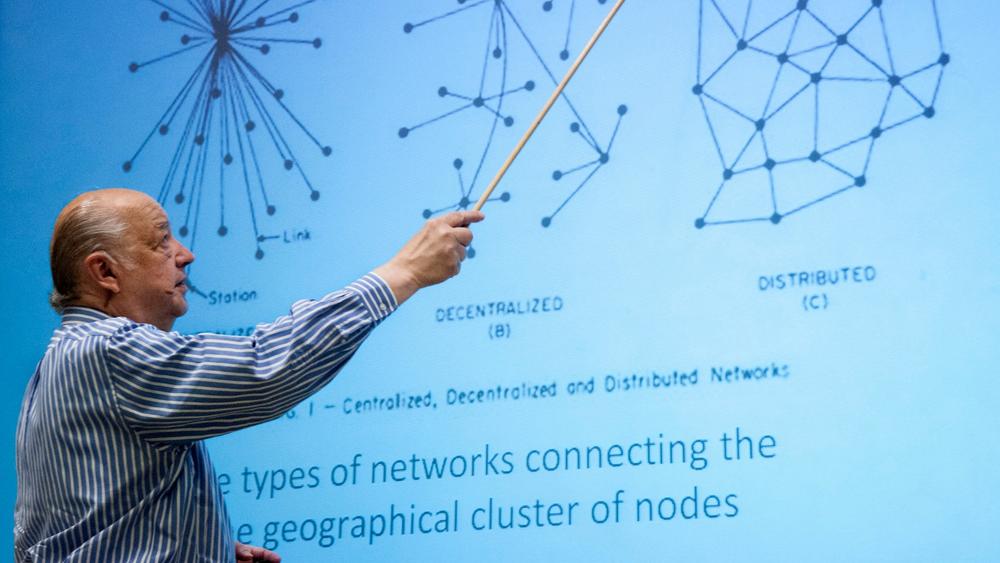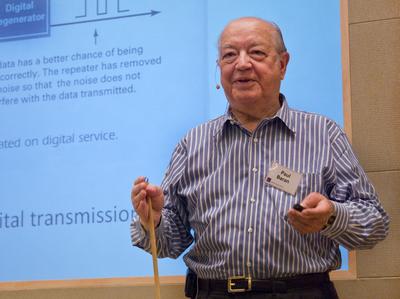Paul Baran and the Origins of the Internet

Paul Baran presents his work at a RAND Alumni Association event on July 25, 2009
Photo by Diane Baldwin/RAND Corporation
In 1962, a nuclear confrontation seemed imminent. The United States and the Union of Soviet Socialist Republics (USSR) were embroiled in the Cuban missile crisis. Both were in the process of building hair-trigger nuclear ballistic missile systems. Each country pondered post-nuclear attack scenarios.
U.S. authorities considered ways to communicate in the aftermath of a nuclear attack. How could any sort of “command and control network” survive? Paul Baran, a researcher at RAND, offered a solution: design a more robust communications network using “redundancy” and “digital” technology.
At the time, naysayers dismissed Baran's idea as unfeasible. But working with colleagues at RAND, Baran persisted. This effort would eventually become the foundation for the World Wide Web.
Baran was born in Poland in 1926. In 1928, his family moved to the United States. He attended Drexel University, where he earned a degree in electrical engineering. Afterward, Baran moved to Los Angeles, where he worked for the Hughes Aircraft Company. Taking night classes at UCLA, he earned an engineering master's degree in 1959—the same year he joined RAND.
At that time, RAND focused mostly on Cold War-related military issues. A looming concern was that neither the long-distance telephone plant, nor the basic military command and control network would survive a nuclear attack. Although most of the links would be undamaged, the centralized switching facilities would be destroyed by enemy weapons. Consequently, Baran conceived a system that had no centralized switches and could operate even if many of its links and switching nodes had been destroyed.
Baran envisioned a network of unmanned nodes that would act as switches, routing information from one node to another to their final destinations. The nodes would use a scheme he called “hot-potato routing” or distributed communications.
Packet Switching
Baran also developed the concept of dividing information into “message blocks” before sending them out across the network. Each block would be sent separately and rejoined into a whole when they were received at their destination. A British man named Donald Davies independently devised a very similar system, but he called the message blocks “packets,” a term that was eventually adopted instead of Baran's message blocks.
This method of “packet switching” is a rapid store-and-forward design. When a node receives a packet it stores it, determines the best route to its destination, and sends it to the next node on that path. If there was a problem with a node (or if it had been destroyed), packets would simply be routed around it.
Baran's Vision of the Future
In an interview with Wired magazine, Baran discussed his vision of how the new technology might be used. “Around December 1966, I presented a paper at the American Marketing Association called 'Marketing in the Year 2000.' I described push-and-pull communications and how we're going to do our shopping via a television set and a virtual department store. If you want to buy a drill, you click on Hardware and that shows Tools and you click on that and go deeper.”

Photo by Diane Baldwin/RAND Corporation
In 1969, this “distributed” concept was given its first large-scale test, with the first node installed at UCLA and the seventh node at RAND in Santa Monica. Funded by the Advanced Research Projects Agency and called ARPANET, it was intended for scientists and researchers who wanted to share computers remotely. But within two years, the network's users had turned it into something unforeseen: a high-speed, electronic post office for exchanging technical and personal information.
In 1983, the rapidly expanding network broke off from its military part, which became MILNET. The remainder became what was called ARPANET. In 1989, the ARPANET moniker was retired in favor the “Internet,” which had also been described as the “information superhighway.”
Baran left RAND in 1968 to co-found the Institute for the Future, a nonprofit research group specializing in long-range forecasting. He also started seven companies, five of which eventually became publicly traded companies. He remained an active supporter of RAND and its alumni association until he died in 2011.
Read more about Paul Baran's life and career"On Distributed Communications" Series
While working at RAND on a scheme for U.S. telecommunications infrastructure to survive a “first strike,” Paul Baran conceived of the Internet and digital packet switching, the Internet's underlying data communications technology. His concepts are still employed today; just the terms are different. His seminal work first appeared in a series of RAND studies published between 1960 and 1962 and then finally in the tome “On Distributed Communications,” published in 1964.